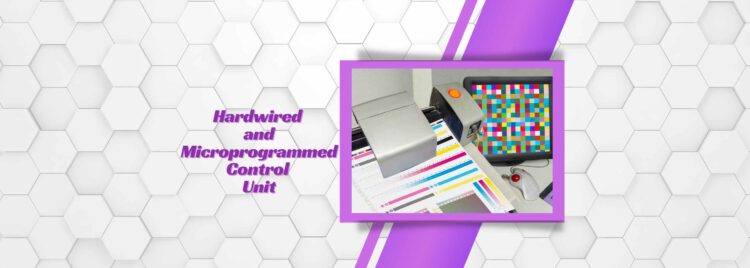Table of Contents
ToggleIntroduction
A Hardwired and Microprogrammed Control Unit is an essential component of a processor that manages the execution of instructions. It takes input from the instruction register and provides signals to various components of the processor to execute the instruction. There are two types of control units: Hardwired and Microprogrammed Control Units.
A Hardwired Control Unit (HCU) is designed using logic gates, flip flops, and other combinational circuits. It is built into the processor and controls the instruction execution by generating control signals directly based on the opcode of the instruction. In contrast, a Microprogrammed Control Unit (MCU) is designed using microcode, which is a low-level program that controls the operation of the processor. The microcode is stored in a Hardwired and Microprogrammed Control Unit and is executed by the MCU to generate control signals for the processor components.
Hardwired and Microprogrammed Control Unit have their advantages and disadvantages, and choosing one over the other depends on the specific requirements of the system. This blog will explore the differences between Hardwired and Microprogrammed Control unit, their respective advantages and disadvantages, and how they work.
Micro programmed Control Units

A hardwired control unit (HCU) is a digital circuit that is designed and constructed using a combinational logic circuit to control the execution of instructions in a central processing unit (CPU). The HCU consists of a set of gates, decoders, multiplexers, and other combinational logic elements that are interconnected to form a control path that generates signals that control the operation of the CPU. The control path in the HCU is fixed and determined by the hardware design, which means that it is not programmable.
The operation of the HCU is based on the instruction set architecture (ISA) of the CPU. The HCU reads the opcode of the instruction from the instruction register (IR) and generates the control signals that are required to execute the instruction. The control signals are sent to the different functional units of the CPU, such as the arithmetic logic unit (ALU), the memory unit, and the input/output (I/O) unit, to perform the required operations.
The HCU has a simple design and is easy to implement. It is also fast and efficient because the control signals are generated directly by the hardware without the need for any additional processing. However, the fixed design of the HCU makes it difficult to modify or update the control path, which limits the flexibility of the CPU.
Note:- Click here to know more about: data science course noida
Differences Between Hardwired and Micro programmed Control Units.

Hardwired and Microprogrammed Control Units are two different approaches to designing control units for processors. Here are some of the key differences between Hardwired and Microprogrammed Control Unit:
Architecture: Hardwired control units use a dedicated circuitry to implement control signals and execute instructions, while microprogrammed control units use a control store that contains microcode to generate control signals.
Flexibility: Microprogrammed control units are more flexible than hardwired control units. The microcode can be easily modified or updated to support new instructions or to fix bugs. Hardwired control units, on the other hand, are fixed and cannot be easily modified.
Complexity: Hardwired control units are relatively simple and require less memory, while microprogrammed control units are more complex and require more memory.
Performance: Among Hardwired and Microprogrammed Control Units HCU is faster because they use dedicated hardware to implement control signals. Microprogrammed control units, on the other hand, use a control store that introduces some overhead.
Design time: Designing a hardwired control unit is more time-consuming than designing a microprogrammed control unit because it involves designing a dedicated circuitry. Microprogrammed control units, on the other hand, involve designing microcode, which is less time-consuming.
Overall, the choice between hardwired and microprogrammed control depends on the specific requirements of the processor design.
Click here to learn about: coding
Advantages and Disadvantages of Hardwired Control Units among Hardwired and Microprogrammed Control Units.
Hardwired Control Units (HCU) have been widely used in early digital systems due to their simplicity and low cost. However, they have some limitations compared to Microprogrammed Control Units (MCU), which are becoming more common in modern systems.
Advantages of HCU:
Speed: Among Hardwired and Microprogrammed Control Unit, HCU is faster, since they do not require memory access to execute instructions.
Simplicity: Hardwired control units are relatively simple to design and implement, making them a cost-effective solution for simple systems.
Size: HCU requires less storage space than MCU, making them more suitable for smaller systems.
Disadvantages of HCU:
Limited Flexibility: Among Hardwired and Microprogrammed Control Unit, HCU are inflexible and cannot be easily modified or updated, which makes them less suitable for complex systems that require frequent changes.
Debugging: Debugging a hardwired control unit can be challenging since it is difficult to identify the specific circuit that is causing a problem.
Complexity: HCU is more complex and challenging to design as the size and complexity of the system grow.
Overall, the choice between Hardwired and Microprogrammed Control Units depends on the complexity of the system, design goals, and the need for flexibility. While HCU is suitable for simple and small systems, MCU provides more flexibility, ease of debugging, and better performance for larger and complex systems. These are some specifications of Hardwired and Microprogrammed Control Units.
Also read: data science institute in delhi
Advantages and Disadvantages of Microprogrammed Control Units.

Microprogrammed Control Units (MCUs) have some advantages and disadvantages over Hardwired Control Units (HCUs).
Advantages:
Flexibility: Among Hardwired and Microprogrammed Control Unit, MCU are more flexible. The microcode of an MCU can be easily modified, allowing for changes in the instruction set architecture and the addition of new instructions without changing the hardware.
Simplified Design: The use of microcode in MCUs simplifies the design process as it allows the implementation of complex instructions using a series of simpler microinstructions.
Debugging:Among Hardwired and Microprogrammed Control Unit, Debugging an MCU is easier since the microcode can be changed to identify the cause of a problem.
Re
duced Costs: Since the design process for an MCU is less complex, Among Hardwired and Microprogrammed Control Unit, production cost can be lower than that of an HCU.
Disadvantages:
Slower Execution: Among Hardwired and Microprogrammed Control Unit, The execution time of an MCU is generally slower than an HCU since it needs to go through a microcode sequencing process before executing each instruction.
Complexity: Among Hardwired and Microprogrammed Control Unit,, The microcode used in MCUs can be complex and difficult to understand, making the design process more difficult.
Limited Parallelism: MCUs have limited parallelism due to the sequencing process required to execute each instruction, which can lead to lower performance.
Debugging: Among Hardwired and Microprogrammed Control Unit, Debugging an MCU can be time-consuming and challenging due to the complex microcode used in the design.
Overall, while MCUs offer greater flexibility and simplified design, they may have slower execution time and be more complex to design and debug. It is essential to consider the specific requirements of the application when choosing between HCUs and MCUs.
Real-world Examples of Hardwired Control Units in Computing.

Hardwired control units have been used in various computing systems throughout history. One example is the early IBM System/360, which was a mainframe computer system that used a hardwired control unit. This control unit was responsible for executing instructions and controlling data flow within the computer system. Another example is the DEC PDP-8, which used a hardwired control unit to perform arithmetic and logical operations.
Hardwired control units have also been used in specialized systems such as calculators, where they are used to perform specific arithmetic functions. The Hewlett-Packard HP-35, introduced in 1972, used a hardwired control unit to perform a variety of mathematical operations.
While hardwired control units were widely used in the past, modern computing systems typically use microprogrammed control units. However, some specialized systems still use hardwired control units, particularly in cases where performance and efficiency are critical. For example, some embedded systems and real-time systems use hardwired control units to ensure precise timing and fast execution.
Real-world Examples of Microprogrammed Control Units in Computing.
Microprogrammed control units have been widely used in computing systems to provide greater flexibility and ease of development. Some real-world examples of microprogrammed control units include:
Intel x86 processors: The x86 architecture is a complex instruction set computing (CISC) architecture that uses a microcoded approach for its control unit.
ARM processors: The ARM architecture uses a microprogrammed approach for its control unit. This allows for greater flexibility in implementing different instruction sets and features.
FPGA-based systems: Field-programmable gate arrays (FPGAs) are commonly used in embedded systems and digital signal processing applications. These systems often use microprogrammed control units to provide a high degree of customization and flexibility.
Network routers and switches: These devices often use microprogrammed control units to manage their packet forwarding and routing functionality.
Graphics processing units (GPUs): Modern GPUs use a combination of hardwired and microprogrammed control units to manage their complex processing pipelines.
Overall, microprogrammed control units offer several advantages over hardwired control units, including greater flexibility, easier development, and the ability to support a wide range of instruction sets and features.
Combining Hardwired and Microprogrammed Control Units
Hybrid designs of control units combine the advantages of both hardwired and microprogrammed control units. These designs are commonly used in modern processors to handle complex instructions that require more control signals than what a hardwired control unit can provide.
In hybrid designs, the hardwired control unit handles the simpler instructions while the microprogrammed control unit is used for more complex instructions. The microprogrammed control unit uses microinstructions stored in a control memory to generate the control signals required to execute the instruction.
The benefits of hybrid designs include improved flexibility and reduced design complexity. They also provide faster execution of simple instructions by relying on the hardwired control unit while still being able to handle complex instructions through the microprogrammed control unit.
Modern processors such as Intel’s x86 and AMD’s Ryzen use hybrid designs of control units. This allows them to handle complex instructions such as those used in multimedia applications, while still providing fast execution of simpler instructions.
Future Developments in Control Unit Design
Control unit design has come a long way since the first computers were developed. From simple hardwired circuits to more sophisticated microprogrammed units, the technology has evolved to meet the growing demands of modern computing. However, as technology continues to advance, new challenges and opportunities arise in the field of control unit design.
One area of development is the use of hybrid designs, which combine the best features of both hardwired and microprogrammed control units. This approach allows for greater flexibility and adaptability in system design, while still maintaining the speed and efficiency of a hardwired control unit.
Another area of focus is the development of control units specifically designed for emerging technologies such as quantum computing and neuromorphic computing. These new technologies require specialized control units that can handle the unique demands of these systems.
Challenges in control unit design include dealing with the growing complexity of modern systems, as well as the need for greater power efficiency and the ability to handle large amounts of data in real-time. To meet these challenges, new techniques such as machine learning and artificial intelligence are being applied to control unit design.
Overall, the future of control unit design looks promising, with new opportunities for innovation and advancement. As technology continues to evolve, it will be exciting to see what new developments emerge in the field of control unit design.
Conclusion
In conclusion, the choice between hardwired and microprogrammed control units depends on various factors, such as the complexity of the instruction set, the desired flexibility, and the available resources. Hardwired control units are faster and simpler, but less flexible and harder to modify or upgrade. Microprogrammed control units, on the other hand, are more versatile and easier to modify, but slower and more complex.
Both hardwired and microprogrammed control units have their advantages and disadvantages, and designers must weigh these trade-offs when selecting the best approach for a particular system. Furthermore, hybrid designs that combine both approaches may offer a more balanced solution that leverages the strengths of each approach.
As computing technology continues to evolve, hardwired and microprogrammed control units design will continue to play a critical role in optimizing system performance and efficiency. Advances in hardwar
e and software may enable new control unit architectures and algorithms that can further enhance system performance while maintaining flexibility and ease of use.
Frequently Asked Questions
What is the difference between hardwired and micro programmed control units?
Hardwired control units use physical connections to implement control logic, while microprogrammed control units use a stored program to implement control logic.
What are the advantages of a hardwired control unit?
Hardwired control units are typically faster and more reliable than micro programmed control units. They also require less memory and are simpler to design.
What are the disadvantages of a microprogrammed control unit?
Micro programmed control units are generally slower than hardwired control units, and they require more memory to store the micro program. They are also more complex to design and debug. There are disadvantages of both Hardwired and Micro programmed Control Units.
What are some examples of systems that use hardwired control units?
Early computers such as the ENIAC and the UNIVAC used hardwired control units. Some modern systems, such as some simple embedded systems and control systems, also use hardwired control units.
What are some examples of systems that use microprogrammed control units?
Most modern general-purpose computers, such as personal computers and servers, use microprogrammed control units. Some specialized systems, such as network routers and switches, also use microprogrammed control units.













